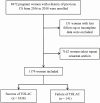Determinants of Successful Vaginal Birth After Cesarean Section: A Retrospective Cohort Study in Southeast China
- PMID: 40322663
- PMCID: PMC12050019
- DOI: 10.2147/IJWH.S507648
Determinants of Successful Vaginal Birth After Cesarean Section: A Retrospective Cohort Study in Southeast China
Abstract
Objective: This study aimed to identify factors influencing the success of a trial of labor after cesarean section (TOLAC) and to evaluate associated maternal and neonatal outcomes.
Methods: A retrospective analysis was conducted on data from women with a prior cesarean section who underwent TOLAC at Fujian Maternity and Child Health Hospital in Southeast China between January 2016 and January 2018. Of the 1179 women who attempted TOLAC, 1038 achieved vaginal birth after cesarean (VBAC) while 141 experienced unsuccessful trials. Sociodemographic and clinical characteristics were compared between the successful and unsuccessful TOLAC groups using the t-test for normally distributed data, non-parametric tests for non-normally distributed data, and the χ2 test, corrected chi-square test, or Fisher's exact test for categorical variables, as appropriate. Logistic regression analysis was performed to identify factors independently associated with successful TOLAC, with the results expressed as Odds Ratios (ORs) and corresponding 95% Confidence Intervals (CIs).
Results: Multivariable logistic regression analysis revealed that maternal height (OR = 1.09, 95% CI = 1.05-1.14), abdominal circumference (OR = 0.95, 95% CI = 0.91-0.98), ultrasound-estimated fetal weight (OR = 0.99, 95% CI = 0.99-1.00), and history of vaginal delivery (OR = 9.62, 95% CI = 2.33-39.67) were independently associated with successful TOLAC. No significant differences were observed between the successful and unsuccessful TOLAC groups in terms of neonatal asphyxia, postpartum hemorrhage, placental abruption, or bladder injury.
Conclusion: Maternal height, abdominal circumference, ultrasound-estimated fetal weight, and history of vaginal delivery were identified as influential factors for VBAC success. Clinical evaluation of these factors may enhance the selection criteria for TOLAC candidates, potentially increasing VBAC rates and reducing cesarean section rates overall.
Keywords: pregnancy outcome; prior cesarean delivery; trial of labor after caesarean section; vaginal birth after caesarean section.
© 2025 Xiu and Lv.
Conflict of interest statement
The authors declare that they have no conflicts of interest in this work.
Figures
Similar articles
-
[Influencing factors and antenatal assessment of the vaginal birth after cesarean section].Zhonghua Fu Chan Ke Za Zhi. 2019 Jun 25;54(6):369-374. doi: 10.3760/cma.j.issn.0529-567x.2019.06.003. Zhonghua Fu Chan Ke Za Zhi. 2019. PMID: 31262120 Chinese.
-
Analysis of influencing factors and establishment of prediction model for successful vaginal delivery after cesarean section.Front Glob Womens Health. 2025 Feb 24;6:1447569. doi: 10.3389/fgwh.2025.1447569. eCollection 2025. Front Glob Womens Health. 2025. PMID: 40066292 Free PMC article. Review.
-
A Trial of Labor after Cesarean Section with a Macrosomic Neonate. Is It Safe?Am J Perinatol. 2024 May;41(S 01):e400-e405. doi: 10.1055/a-1884-1221. Epub 2022 Jun 24. Am J Perinatol. 2024. PMID: 35750318
-
[Clinical study on vaginal birth after cesarean].Zhonghua Fu Chan Ke Za Zhi. 2016 Aug 25;51(8):586-91. doi: 10.3760/cma.j.issn.0529-567X.2016.08.007. Zhonghua Fu Chan Ke Za Zhi. 2016. PMID: 27561937 Clinical Trial. Chinese.
-
Delivery for women with a previous cesarean: guidelines for clinical practice from the French College of Gynecologists and Obstetricians (CNGOF).Eur J Obstet Gynecol Reprod Biol. 2013 Sep;170(1):25-32. doi: 10.1016/j.ejogrb.2013.05.015. Epub 2013 Jun 28. Eur J Obstet Gynecol Reprod Biol. 2013. PMID: 23810846 Review.
References
LinkOut - more resources
Full Text Sources


